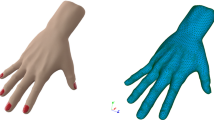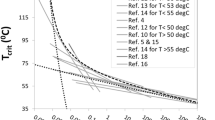Abstract
This work develops a model for thermally induced damage from high current flow through biological tissue. Using the first law of thermodynamics, the balance of energy produced by the current and the energy absorbed by the tissue are investigated. The tissue damage is correlated with an evolution law that is activated upon exceeding a temperature threshold. As an example, the Fung material model is used. For certain parameter choices, the Fung material law has the ability to absorb relatively significant amounts of energy, due to its inherent exponential response character, thus, to some extent, mitigating possible tissue damage. Numerical examples are provided to illustrate the model’s behavior.




Similar content being viewed by others
Notes
The Second Piola-Kirchhoff stress is related to the Cauchy stress (\({{\varvec{T}}}\)) via \({{\varvec{T}}}=\frac{1}{J}{{\varvec{F}}}\cdot {{\varvec{S}}}\cdot {{\varvec{F}}}^T\). Although we will employ referential formulations in the analysis to follow, we note that in the current configuration we have \(\displaystyle {\rho \dot{w}-{{\varvec{T}}}:\nabla _x\dot{{{\varvec{v}}}}+\nabla _x \cdot {{\varvec{q}}}-Z=0}\), where \({{\varvec{T}}}\) is the Cauchy stress, \({{\varvec{v}}}\) is the material velocity, \(\rho \) is the density, and \({{\varvec{q}}}\) is the heat flux.
In the case of isotropy, Hooke’s law can be written in terms of the bulk \(\kappa \) and shear moduli \(\mu \) as \({\varvec{\sigma }}={{\varvec{I}}}\!{{\varvec{E}}}:{\varvec{\epsilon }}=3\kappa \frac{tr({{\varvec{\epsilon }}})}{3}\mathbf{1}+2\mu {{\varvec{\epsilon }}}^{\prime }\), where \({{\varvec{\epsilon }}}^{\prime }={\varvec{\epsilon }}-\frac{tr({{\varvec{\epsilon }}})}{3}\mathbf{1}\).
For further details on these types of phenomenological (damage) formulations, the interested reader is referred to the seminal work of Kachanov (1986).
References
Adukauskiene D, Vizgirdaite V, Mazeikiene S (2007) Electrical injuries. Medicina (Kaunas) 43(3):259–266
Chen MQ, Wong J, Kuhl E, Giovangrandi L, Kovacs GTA (2011) Characterization of electrophysiological conduction in cardiomyocyte co-cultures using co-occurrence analysis. Comp Meth Biomech Biomed Eng. doi:10.1080/10255842.2011.615310
Cooper MA (1995) Emergent care of lightning and electrical injuries. Semin Neurol 15(3):268–78
Cushing T (2011) Electrical injuries in emergency medicine. Medscape Reference. Web. 29, September 2011
Dal H, Göktepe S, Kaliske M, Kuhl E (2012) A fully implicit finite element method for bidomain models of cardiac electrophysiology. Comp Meth Biomech Biomed Eng 15:645–656
Dal H, Göktepe S, Kaliske M, Kuhl E (2013) A fully implicit finite element method for bidomain models of cardiac electromechanics. Comp Meth Appl Mech Eng 253:323–336
Demkowicz (2006) Computing with hp-adaptive finite elements. I. One- and two- dimensional elliptic and Maxwell problems. CRC Press, Taylor and Francis
Demkowicz L, Kurtz J, Pardo D, Paszynski M, Rachowicz W, Zdunek A (2007) Computing with hp-adaptive finite elements, vol 2: frontiers: three dimensional elliptic and Maxwell problems with applications. CRC Press, Taylor and Francis
Fontanarosa PB (1993) Electrical shock and lightning strike. Ann Emerg Med 22(2 Pt 2):378–87
Fung YC (1967) Elasticity of soft tissues in simple elongation. Am J Physiol 28:1532–1544
Fung YC (1973) Biorheology of soft tissues. Biorheology 10:139–155
Fung YC (1983) On the foundations of biomechanics. ASME J Appl Mech 50:1003–1009
Göktepe S, Kuhl E (2010) Electromechanics of the heart: a unified approach to the strongly coupled excitation–contraction problem. Comp Mech 45:227–243
Hashin Z (1983) Analysis of composite materials: a survey. ASME J Appl Mech 50:481–505
Holzapfel GA (2001) Biomechanics of soft tissue. In: Lemaitre J (ed) The handbook of materials behavior models, vol III, Multiphysics behaviors, Chapter 10, Composite media, Biomaterials. Academic Press, Boston, pp 1049–1063
Holzapfel GA, Ogden RW (2009) Biomechanical modeling at the molecular, cellular and tissue levels. Springer, Berlin
Huet C (1982) Universal conditions for assimilation of a heterogeneous material to an effective medium. Mech Res Commun 9(3):165–170
Huet C (1984) On the definition and experimental determination of effective constitutive equations for heterogeneous materials. Mech Res Commun 11(3):195–200
Humphrey JD (2002) Cardiovascular solid mechanics. Cells, tissues, and organs. Springer, New York
Humphrey JD (2003) Continuum biomechanics of soft biological tissues. Proc R Soc 459(2029):3–46
Hurtado D, Kuhl E (2012) Computational modeling of electrocardiograms: Repolarization and T-wave polarity in the human heart. Comp Meth Biomech Biomed Eng. doi:10.1080/10255842.2012.729582
Jikov VV, Kozlov SM, Olenik OA (1994) Homogenization of differential operators and integral functionals. Springer, Berlin
Kachanov LM (1986) Introduction to continuum damage mechanics. Martinus Nijoff, Dordricht
Kachanov M (1993) Elastic solids with many cracks and related problems. Advance applied mechanics, vol 30. Academic Press, New York
Kachanov M, Tsukrov I, Shafiro B (1994) Effective moduli of solids with cavities of various shapes. Appl Mech Rev 47:S151–S174
Kachanov M, Sevostianov I (2005) On the quantitative characterization of microstructures and effective properties. Int J Solids Struct 42:309–336
Kotikanyadanam M, Göktepe S, Kuhl E (2010) Computational modeling of electrocardiograms: a finite element approach towards cardiac excitation. Int J Num Meth Biomed Eng 26:524–533
Lederer W, Kroesen G (2005) Emergency treatment of injuries following lightning and electrical accidents. Anaesthesist 54(11):1120–9
Markenscoff X (2001a) Diffusion induced instability. Q Appl Mech LIX(1):147–151
Markenscoff X (2001b) Instabilities of a thermo-mechano-chemical system. Q Appl Mech LIX(3):471–477
Markenscoff X (2003) On conditions of “negative creep” in amorphous solids. Mech Mater 35(3–6):553–557
Markov KZ (2000) Elementary micromechanics of heterogeneous media. In: Markov KZ, Preziozi L (eds) Heterogeneous media: micromechanics modeling methods and simulations. Birkhauser, Boston, pp 1–162
Maxwell JC (1867) On the dynamical theory of gases. Philos Trans Soc Lond. 157:49
Maxwell JC (1873) A treatise on electricity and magnetism, 3rd edn. Clarendon Press, Oxford
Mura T (1993) Micromechanics of defects in solids, 2nd edn. Kluwer, Berlin
Nemat-Nasser S, Hori M (1999) Micromechanics: overall properties of heterogeneous solids, 2nd edn. Elsevier, Amsterdam
Rayleigh JW (1892) On the influence of obstacles arranged in rectangular order upon properties of a medium. Philos Mag 32:481–491
Sevostianov I, Gorbatikh L, Kachanov M (2001) Recovery of information of porous/microcracked materials from the effective elastic/conductive properties. Mater Sci Eng A 318:1–14
Sevostianov I, Kachanov M (2008) Connections between elastic and conductive properties of heterogeneous materials. Adv Appl Mech 42:69–253
Torquato S (2002) Random heterogeneous materials: microstructure and macroscopic properties. Springer, New York
Wong J, Göktepe S, Kuhl E (2011) Computational modeling of electrochemical coupling: a novel finite element approach towards ionic models for cardiac electrophysiology. Comp Meth Appl Mech Eng 200:3139–3158
Xu X, Zhu W, Wu Y (1999) Experience of the treatment of severe electric burns on special parts of the body. Ann NY Acad Sci 888:121–130
Zohdi TI, Wriggers P (2008) Introduction to computational micromechanics. Springer, Berlin
Zohdi TI (2010) Simulation of coupled microscale multiphysical-fields in particulate-doped dielectrics with staggered adaptive FDTD. Comput Methods Appl Mech Eng 199:79–101
Author information
Authors and Affiliations
Corresponding author
Appendix: Joule heating
Appendix: Joule heating
Joule heating can be explicitly identified by considering Faraday’s Law
and Ampere’s Law
where we recall that \({\varvec{\mathcal{E }}}\) is the electric field, \({\varvec{\mathcal{D }}}\) is the electric field flux, \({\varvec{\mathcal{J }}}\) is the electric current, \({\varvec{\mathcal{H }}}\) is the magnetic field, and \({\varvec{\mathcal{B }}}\) is the magnetic field flux. Joule heating can be motivated by forming the inner product of the magnetic field with Faraday’s law and the inner product of the electric field with Ampere’s law and forming the difference to yield
where \(\mathcal{W}=\frac{1}{2}({\varvec{\mathcal{E }}}\cdot {\varvec{\mathcal{D }}}+{\varvec{\mathcal{H }}}\cdot {\varvec{\mathcal{B }}})\) is the electromagnetic energy and where \({\varvec{\mathcal{S }}}={\varvec{\mathcal{E }}}\times {\varvec{\mathcal{H }}}\) is the Poynting vector. Thus,
Equation 7.4 is usually referred to as Poynting’s theorem and can be interpreted as stating that the rate of change of electromagnetic energy within a volume, plus the energy flowing out through the material, is equal to the negative of the total work done by the fields on the sources and electrical conduction. We consider the absorbed energy that is available for heating to be proportional to the energy associated with current flow (\({\varvec{\mathcal{J }}}\cdot {\varvec{\mathcal{E }}}\)) in Eq. 7.4.
Rights and permissions
About this article
Cite this article
Zohdi, T.I. Modeling electrical power absorption and thermally-induced biological tissue damage. Biomech Model Mechanobiol 13, 115–121 (2014). https://doi.org/10.1007/s10237-013-0489-9
Received:
Accepted:
Published:
Issue Date:
DOI: https://doi.org/10.1007/s10237-013-0489-9





